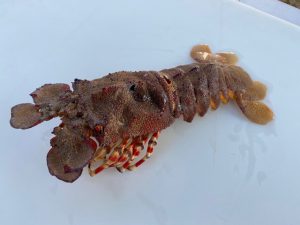
Year-round lobster seasons?! Besides the Caribbean spiny lobster (Pannulirus argus), there are 3 other commonly found species of lobster in Florida, the spotted spiny lobster (Panulrius guttatus), Spanish lobster (Scyllarides aequinoctialis) and the ridged slipper lobster (Scyllarides nodifer). Unlike the Caribbean spiny lobster, these other lobsters are “unregulated” meaning they do not have a minimum size limit or season; however, egg bearing females must be released. In Florida, aquatic species that are “unregulated” have a daily harvest limit of “two fish or 100 pounds per person per day- whichever is more” the rule can be found here. However, there are some areas in Everglades National Park, Biscayne Bay and Monroe County that are protected and have lobster restrictions that can affect the harvest of unregulated lobster species. If you’re planning to harvest bugs anywhere near those areas, be sure to consult regulations specific to those locations.
In Southwest Florida you’re good to harvest the spotted spiny, Spanish and ridged slipper lobster year-round if you aren’t within the boundaries of the Dry Tortugas or Everglades National Park. Most of these unregulated bugs mentioned above will be caught as by-catch while lobstering or spearfishing as they can be more elusive hiding deep within or upside down in structures/holes.
The Other Spiny Lobster:
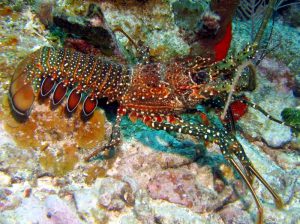
Among the 3 commonly found unregulated lobster species, the spotted spiny lobster is the least likely found in the Gulf. This decapod usually seeks refuge on the underside of large bouldering coral heads such as the great star coral (Montastraea cavernosa) or deep within the structures like rock jetties that are in areas with not much fluctuation in salinity or temperature. Spotted spinys are more frequently found near Southeast Florida or the Keys where these coral heads are more common, and inshore conditions are less estuarine. These lobsters are generally much smaller than their cousin the Caribbean spiny lobster, a large spotted spiny would be similar size to a barely legal Caribbean spiny lobster.
Slipper Lobster:
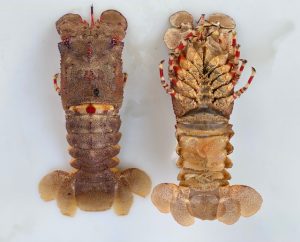
The Spanish and ridged slipper lobster are often lumped together as “slipper lobster” or “shovel nosed lobster.” The Spanish lobster have a smoother carapace and can be a mottled orange-red color, while ridged slipper lobster have raised rough features and cryptic rock like coloration. An easy way to tell these two species apart is by checking out their legs, ridged slipper lobsters have a distinct candy cane pattern while Spanish lobster are uniform in leg color. In the Gulf, divers find slipper lobster more frequently than lobsters of the spiny variety.
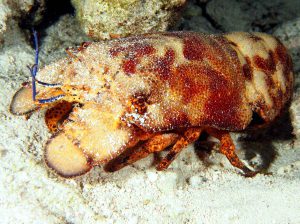
Slipper lobster take refuge in cracks, ledges and often inhabit the same swiss-cheese pothole bottom as red grouper. Be sure to check the inside of grouper holes with a flashlight as the slipper lobster can be harder to spot than their spiny cousins. Spanish and ridged slipper lobster don’t have long easy to see antennae but instead have plate like ones that give them their “bulldozer” appearance. Just like the spiny lobster, its common to find multiple slipper lobster in close proximity, so check the area thoroughly if you find one! On average, both species of slipper lobster are smaller than Caribbean spiny lobster and are usually around 8-12 inches in total length.
Cooking Tips:

In my opinion and the opinion of many others, slippers and spotted spiny lobster taste just as good if not better than Caribbean spiny lobsters and can be prepared in a similar fashion. When grilling slipper lobster tails, I like to cut the shell completely off from the underside of the tail and grill as if the lobster was on its “back.” I keep the tail from rolling one side or another by lightly balling some aluminum foil and pressing the tail in to create a “saddle.” Now you have the perfect apparatus to keep your butter and seasonings in contact with the lobster and prevent them from dripping off in the flames! Expand your seafood pallet and try some today!
Other Unregulated Lobster Species:
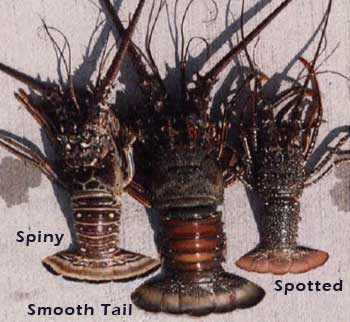
There is one more species of spiny lobster that can be found in Florida but finding one is very uncommon. The smooth tail spiny lobster (Panulirus Laevicauda) has been caught off Florida’s East coast but I haven’t heard of any reports of them being found in the Gulf. There are also a few other species of slipper lobster that divers occasionally bump into. The Chace slipper lobster (Scyllarides chacei) and the sculptured slipper lobster (Parribacus antarcticus) can be found around Florida but are considerably rarer to find than the Spanish and ridged slipper lobster. When reviewing lobster regulations set by the Gulf of Mexico Fishery Management Council and NOAA, another family of lobster was mentioned, Synaxidae or furry lobster, these bugs would fall within the same restrictions as the “unregulated” variety but honestly I did not know people harvested them.
References And Further Readings:
https://www.floridagofishing.com/species/lobsters-south-atlantic-and-gulf.html
https://s3.amazonaws.com/img.stateparkhq.com/files/JPCR%20LOBSTER%20BROCHURE%202015-16.pdf
http://npmaps.com/wp-content/uploads/biscayne-lobster-sanctuary-map.gif
https://myfwc.com/fishing/saltwater/recreational/unregulated/
http://gulfcouncil.org/wp-content/uploads/K-5b-Final-Draft-Spiny-Lobster-Amendment-13.pdf
 2
2

Comments:
March 30, 2022
Yes, there is. All information can be found here: https://www.collieredo.org/culinary-accelerator
March 11, 2022
Great comment! I have read that sago palm is susceptible to ganoderma sadly...
February 28, 2022
When folks who have lost a palm to ganoderma here, they usually want something that looks like a palm. Here in Indian River County, I suggest 3 plants which sort-of resemble palms: Sago Palm, which is a cycad but really resembles a plam Ponytail palm, which is not a plam nor a cycad and Pandanus, or "Screw Pine", which is neither a palm nor a pine but a very interesting tropical plant with a very large, interesting round cone-type seed pod when mature and spiraling leaf arrangement.
January 23, 2022
I admire your blog , it has of lot of information. You just got one perennial visitor of this blog!
August 11, 2021
Very, very expensive
June 24, 2021
That's a tricky one as slippers/bulldozers are not as targeted by commercial divers and I don't believe many slippers get caught in regular spiny lobster traps. I would reach out to some local seafood houses to see if they get them in occasionally, request them from a distributor or if they get some of their product by divers, ask if you could make a request or be contacted when they come in. I know a few Tampa area commercial divers and I believe they sell their speared fish to Shelly's Seafood and would check with them https://www.shellysseafood.com/. Good luck!
June 24, 2021
I am looking to buy 20 lb of slipper lobster bulldozer lobster spiny lobster and looking for some place in Tampa area to purchase them
June 1, 2021
I want to give thanks to you for sharing such good information
June 1, 2021
pretty good informative
April 20, 2021
Is there a membership for this program?
March 29, 2021
Hi Earl, I would be happy to take a look at a picture, my email address is sipos624@ufl.edu. Cane toads and other invasive species are usually/can be more common in urban and disturbed areas where the native critters are pushed out leaving an open ecological niche. I did a search of the Everglades Conservation Area 2 A and looks like it backs up to some urban areas on the East side. The FWC promotes reporting sightings of invasive species as the best form of management is early detection and rapid response before the species become established. You could report the sighting on the I've Got One app or on this website (url below), you can also see where some invasive critters have been spotted/reported as well https://www.eddmaps.org/distribution/ . For cane toads they may not mobilize a response as they have been established but researchers could find the information useful and interesting if they are moving more towards rural undisturbed areas. -Mike
March 27, 2021
I got this last night in Everglades Conservation Area 2A. miles from anything dry. It looks like a cane toad and is the size of a bullfrog. secretions from the glands behind the head. if it is a cane toad, and they are reproducing, bad news for natvive glades frogs. i cant figure out how to attach photos but glad to email to you.
January 8, 2021
Great video on sheepshead feeding. Thanks for posting this.
October 30, 2020
Our HOA is requiring residents to hire a tree trimming company to remove the royal palm seed pods ($55 per tree). Do you have any written materials to support nature's "self pruning" of royal palms? The royal palms on our property have never been pruned but the new HOA is determined to excessively prune these palms. Any help would be appreciated. Thank you for your time.
October 1, 2020
I just watched NBC2 news with Twyla Leigh and the Vanilla Bean vine plant. My friend, Dr. Henry Herman, Professor at FSW in Fort Myers, gave me a cutting of his plant and it was amazing how healthy it was and grew to flower. I had moved from that home, but would love to have samples to grow at my home in South Fort Myers. I am a master gardener and would love to help produce more Vanilla Bean Orchid plants. Please contact Twyla Leigh at twlaleigh@ufl.edu
September 24, 2020
I just watched NBC2 news with Twyla Leigh and the Vanilla Bean vine plant. My friend, Dr. Henry Herman, Professor at FSW in Fort Myers, gave me a cutting of his plant and it was amazing how healthy it was and grew to flower. I had moved from that home, but would love to have samples to grow at my home in South Fort Myers. I am a master gardener and would love to help produce more Vanilla Bean Orchid plants.
September 22, 2020
Hi Albrey, The pictures are great! I believe there is a huge value of having real fish pictures for identification. I'm beginning to stockpile photos of distinguishing characteristics for all the species I now catch/do a segment on. I'm trying to do a species profile/fillet video a week on edible fish found in Florida on our Collier County Sea Grant Facebook page https://www.facebook.com/CollierSeaGrant
September 22, 2020
Nice to see you using the helpful species identification clues provided in Fish Rules App. Swipe pics in Fish Rules App to see additional images and identification clues.
June 11, 2020
the internet. You actually know how to bring a problem to light
June 8, 2020
Thank you for your kind words! If there are any invasive species you're interested in particular, I would be happy to answer your questions or put you in contact with an expert within the University of Florida network. Feel free to reach out with any requests or ideas for future programming. Have a good one!
June 5, 2020
This short article was such a good read that will I will definitely recommend it to the friends! The last moment I’ve read some thing as professionally composed was with at https://www.onlinetutorforme.com/portuguese-tutor/. Thank a person for the professionalism and a watch regarding details. Is going to be pleased to read a lot more of your respective writing!
May 11, 2020
Thanks for your info--i didn't realize this was the problem with my porterweed until the plants were quite infected with the caterpillars. I've cut the stems as you suggest...but continually find many I've missed. The infestation is pretty established. What's the best course of action? I've cut back the porterweed substantially, but probably the moths are around and will continue to infect. If I remove the porterweed completely...and start over, must I continually (almost daily) check the plants for infestation? I've had the plants for a few years before the problem occurred.
May 3, 2020
i have a big infestation of this on my native porter weed. Didn't really notice it until it has really devasted my plants an is spreading. It is overwhelming the plants. The caterpiller appears to burrow down inside the stem and then the branch dies. It may be too late for me to control it by just cutting the infected stems out. How do I get these insects under control. Do I need to remove all the porter weed and let the ground remain dormant for a while? I have the infestation in my backyard, but have porterweed in the front also, and I observed early signs of infestation in the front. Would appreciate your advice. So glad you've identified my problem.
January 21, 2020
Thank you so much! Wish so many of my "natives" and Florida friendly, like Wild Coffee, were a bit more cold sensitive. Not sure how I'll have time and ability to protect my 100' hedge row, but we'll give it a valiant try.
January 9, 2020
You're very right about that! We completely agree!
December 27, 2019
I want to give thanks to you for sharing such good information!! North Shore Tree Services
September 23, 2019
Great Share! Hastings Tree Surgeon
August 22, 2019
Cool stuff. Tree Service
December 3, 2018
George, let's set up a time to talk! Give the Extension Office a ring: 239-252-4800 - Jessica
September 21, 2018
Who do I need too talk to the bosses on location??? Am a great talented Chef wanting my own business truck.And knowing dealing Bosses but you. Z And to put healthy great food for the tourists. I leave here for 5years and know know proveries and fisherman.. Gradauted CIAn 2005, like to know permits and costs before I get a food truck please let me know. Best Regards, George Vassilev
September 4, 2018
Hi Seth, the event has already passed. Feel free to call our Collier County Extension Office at 239-252-4800.
August 31, 2018
Hi I want to buy 2 tickets to the Collier county tropical fruit road tour please give me a number to contact someone the link is not working for me. thank you
August 28, 2018
For the royal poinciana caterpillar, carbaryl or a pyrethroid (bifenthrin) should work. Remember just to spray the bole of the tree from the ground up to 3 or 4 feet. No need to spray the canopy as explained in the posted FSHS article.
August 28, 2018
So what do we use to kill them? Seven?
July 18, 2018
Love the pics!!!!
March 15, 2018
Can't seem to be able to sign up for the ag tour. Would like to go, are there any available seats left. Thanks, Joyce Berkoski 239 732 5847
December 8, 2017
I want to compliment Jill for being the Naples face of American Farms. She is innovative knowledgeable and personable. You have a true Gem!
December 6, 2017
We in Iowa followed the hurricane devastation in Naples and its impact on American Farms. Kudos to Alex and the employees for their efforts to rebuild.
Comments are closed.